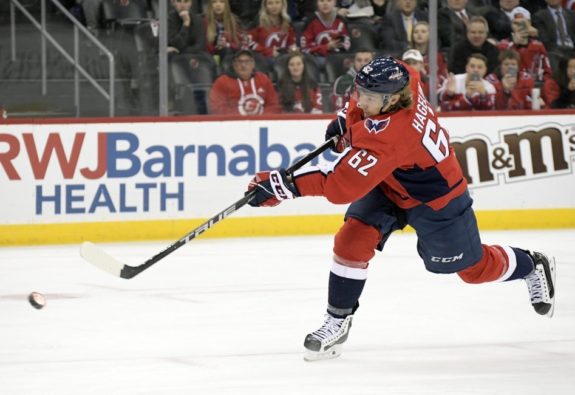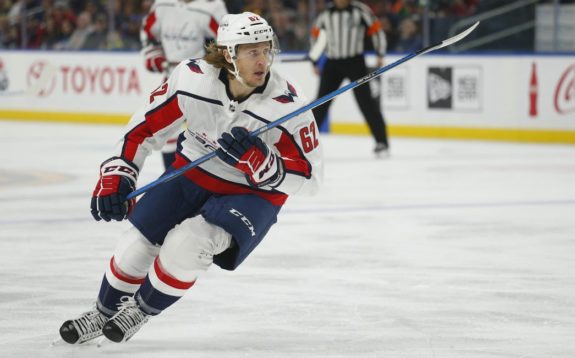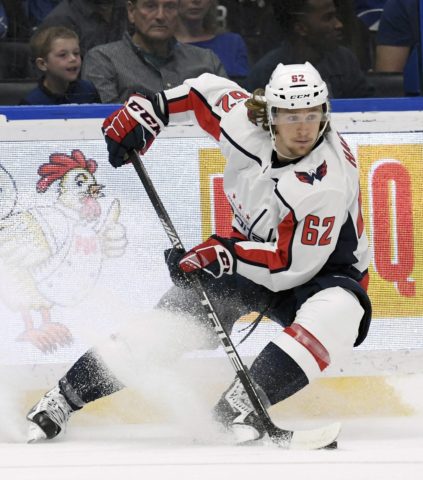The Eastern Conference round robin is underway to determine seeding for the playoffs. The first slate of games is complete, with the Washington Capitals falling to the Tampa Bay Lightning in a shootout on Monday afternoon.
It was a disjointed offensive effort for much of the game from Washington, but as the club took its time finding a consistent attack, Carl Hagelin stole opportunities to put pressure on and keep the Lightning on their toes. Though there’s nothing special about his effort in the box score, the veteran third-liner provided the exact kind of effort that has made him a mainstay on Cup contenders throughout his career.
Carl Hagelin: Definition of a Journeyman
The 31-year-old Hagelin is a journeyman in the most classic sense. He’s been traded four times. That means he’s routinely viewed as expendable — and other clubs routinely desire his services. Of course, that’s the nature of a journeyman — both are true. He’s not such a tremendous or unique talent that he can’t be replaced, but there’s no doubt he has the skills and wherewithal to contribute to a contender.

You might go so far as to say he’s a disappointment. Physically gifted enough to pot 15 goals perennially, but his stick skills can’t seem to get him there. He’s rarely risen above the third line with the New York Rangers, Anaheim Ducks, Pittsburgh Penguins, Los Angeles Kings or the Capitals. Still, the Caps gave up quite a bit to get him (a third and sixth-round pick), proving exactly how much they value him in their bottom-six.
Capitals’ Third-Line Advantage
Hagelin’s experience on the third line can’t be undersold. With 128 playoff games under his belt and two Stanley Cups, he teams with Lars Eller and Ilya Kovalchuk on an absurdly decorated third line. Kovalchuk can create offense, and Eller can manage the offense (though he looked a little sloppy with his passes on Monday). Hagelin and Eller also proved capable of folding Richard Panik back into the line on Monday. Panik scored his goal while skating on the third line after a penalty mixed up the lines.

Playing with offensively minded forwards allows Hagelin to play with speed, to steal loose pucks, grind on defense, and snipe transition opportunities. He’s an aggressive forechecker and sound defensive player who knows where to be on the ice. He’s key for the Capitals’ penalty-kill efforts.
Related: Alex Ovechkin’s Milestones Through the Years
Again, he’s not going to score a ton for the offense, and he’s not always going to finish when he breaks away, but he’s faster than he seems and plays within himself to constantly press the issue. You can’t fall asleep on him. He’s the type of player who can steal extra possessions for the offense, which actually makes him a perfect line partner for Eller and Kovalchuk.
Performance Versus Lightning
For the first period and much of the second on Monday, the Capitals trailed the Lightning and struggled to muster sustained runs on goal. Evgeny Kuznetsov scored on a creative deke against Andrei Vasilevskiy, T.J. Oshie put some pressure on in the third period, and the veteran Kovalchuk was active throughout the game in keeping the puck in Tampa’s end. But it was an opportunistic approach — and some extra aggression from temporary alternative captain Oshie — that turned the tide to keep the Capitals in the game.

Without much offensive continuity in the first period, quick-strike opportunities can make the difference, and in that regard, it was Hagelin who came away with the best looks. He’s not a great finisher — and he didn’t end up potting a goal — but sometimes the threat of a goal is enough to balance momentum and keep the other team from closing their fist.
Value in a Missed Opportunity
Around 90 seconds into the game, Hagelin’s sneaky speed put him on a breakaway for a chance at an early goal. Obviously, the Capitals would prefer he finish on an opportunity like that. Even though those moments make hockey feel like a zero-sum game, it’s really not. Those moments matter. Hagelin’s pressure and energy kept the Capitals competitive while the rest of the offense found their legs.
He had another such opportunity on a great cross-court pass off the boards immediately after their first goal. Again, he didn’t finish the opportunity, but even being in that spot shows his intelligence on the ice and gives the rest of his teammates some fire while putting that little speck of doubt in the back of the opponent’s mind.

The Capitals weren’t able to put together consistent offense in the Tampa end, and they no doubt missed John Carlson in that regard. (from ‘Waiting for John Carlson and other observations from the Capitals’ OT loss,’ The Athletic, 08/03/2020) The defensemen had their hands full keeping up with the speed of Brayden Point and a multi-faceted Tampa approach (even sans Steven Stamkos). Carlson should help quarterback more reliable offense in their opponent’s end once he’s back.

Without him, the Caps don’t have another defenseman to spearhead that kind of effort. They turned to a more physical brand of hockey. The engine of the offense, then, is powered by their top-six forwards. Without much blue line support — and without much of a game from Alex Ovechkin — it falls to the bottom-six to generate supplemental offense. In this game, at least, Hagelin, Kovalchuk, and Panik proved up to the task.
Related: Lightning All-Decade Team: Offense
Hagelin has long been a frustrating player to follow in the NHL because of his tantalizing speed and tendency to disappear for stretches. But the qualities that make him tough to root for are the same qualities that make him tough to play against. As the Swedish winger approaches his 32nd birthday this month, it’s time to appreciate his game in proper context: his speed, stick checking skills, and solid positioning don’t make him a dormant point-getter – they make him a penalty killer, a neutral zone denizen, and at times, exactly what the Capitals need.